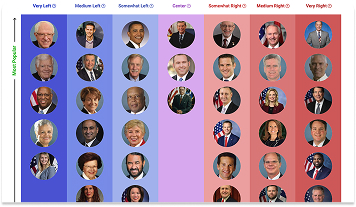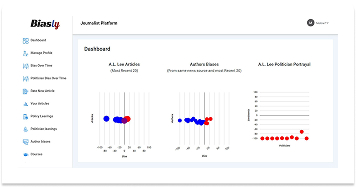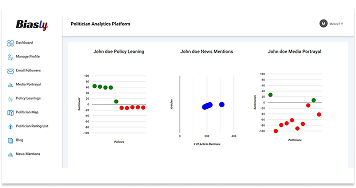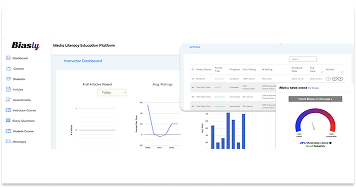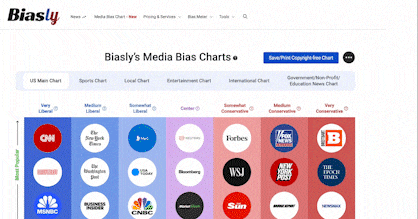Bias Meter
Extremely
Liberal
Very
Liberal
Somewhat Liberal
Center
Somewhat Conservative
Very
Conservative
Extremely
Conservative
-100%
Liberal
100%
Conservative
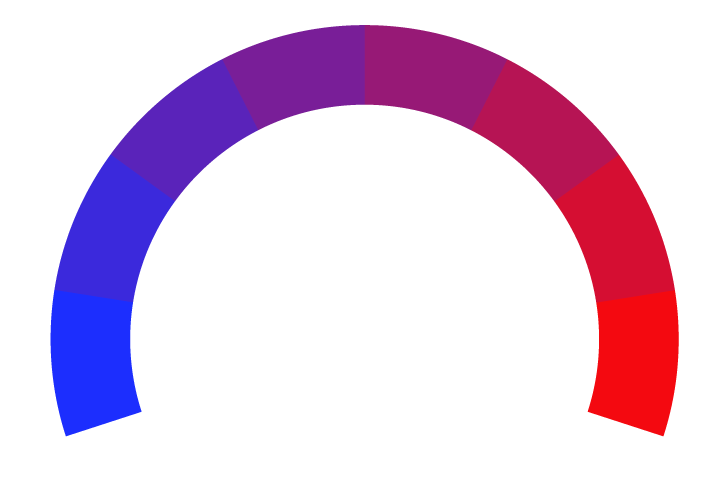
Biasly determines media bias ratings through a dual-layered approach combining artificial intelligence and analyst review. The platform’s proprietary bias detection engine, Bias Meter, evaluates sentiment, policy position alignment, and language framing across thousands of data points in news articles. Analysts then verify and interpret the AI’s findings, providing additional context where needed. Learn more
- Profile
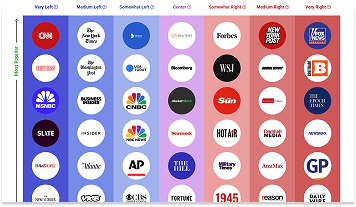
Forbes on the media bias chart
Forbes has a Bias Score of 10% Center which is based on a variety of factors including its policy and politician leanings, article ratings, and the use of biased language. Its Reliability is rated as Good, and additional analytical insights are available in the other tabs.
- Bias Rating
10% Center
- ReliabilityPolicy Leanings
18% Somewhat Right
Extremely
LiberalVery
LiberalModerately
LiberalSomewhat Liberal
Center
Somewhat Conservative
Moderately
ConservativeVery
ConservativeExtremely
Conservative-100%
Liberal100%
Conservative
Average Reliability
*Our bias meter rating uses data science including sentiment analysis, machine learning and our proprietary algorithm for determining biases in news articles. Bias scores are on a scale of -100% to 100% with higher negative scores being more liberal and higher positive scores being more conservative and 0% being neutral. The rating is an independent analysis and is not affiliated nor sponsored by the news source or any other organization.
Politician Portrayal13% negative
Continue For Free
Create your free account to see the in-depth bias analytics and more.
By creating an account, you agree to our Terms and Privacy Policy, and subscribe to email updates.
Policy Leanings Analysis
Policy | Bias score |
|---|
Forbes Editorial Patterns
Forbes’ coverage of political topics often reflects a Center bias, with consistent patterns in phrasing, source selection, and thematic focus that lean center. While the publication demonstrates journalistic standards in many of its reports, the choice of issues, framing, and word usage can indicate a political slant. This content analysis examines how Forbes handles liberal and conservative issues and evaluates its language choices and editorial tendencies.
Coverage of Liberal vs. Conservative Topics
Forbes frequently covers climate change, clean energy, social equity, and diversity in leadership. These issues align with liberal policy priorities. Articles often highlight ESG (Environmental, Social, Governance) strategies, especially in finance and corporate responsibility. Writers profile progressive entrepreneurs, renewable innovations, and DEI (Diversity, Equity, Inclusion) metrics. Forbes promotes startup culture, tech disruption, and alternative education—values common among younger, liberal-leaning readers. Coverage of healthcare access and student debt includes sympathetic tones and reform-friendly framing. Liberal topics receive prominent placement during election cycles or policy shifts.
Conservative issues such as tax cuts, deregulation, and Second Amendment economics are less frequent but still present. Forbes reports on business deregulation under Republican administrations with neutral-to-positive framing. Coverage of oil, gas, and traditional manufacturing includes discussion on economic necessity and job impact. Some authors explore border wall legislation or free trade policies through a business lens. Stories on corporate lobbying, defense contracts, and private equity often align with capitalist policy. However, cultural conservatism—abortion, religion, or gender politics—rarely appears unless tied to economic outcomes.
Forbes frames liberal topics as innovation, and conservative ones as stability or pragmatism. The tone often depends on economic relevance. Liberal-leaning coverage stresses future growth, tech-driven change, and social entrepreneurship. Conservative-leaning content focuses on legacy wealth, risk mitigation, and operational efficiency. Instead of publishing many traditional opinion columns, Forbes uses advisory articles to promote specific views grounded in research and cross-examined facts. Even when discussing polarizing topics, Forbes emphasizes financial impact over ideological loyalty. This approach preserves a broad readership across political lines.
Policy and Issue Framing
Forbes frames policies primarily through their economic impact on businesses and investors. It focuses on how regulations affect profitability and growth. Instead of ideological debate, articles assess costs, benefits, and market responses. Tax policies are analyzed for effects on capital investment and job creation. Environmental regulations are often discussed with emphasis on innovation opportunities and compliance challenges. Healthcare and education policies are framed around workforce productivity and talent development. This economic lens creates a pragmatic view appealing to business professionals.
Forbes covers social and political issues by focusing on their impact on business strategy and consumers. Topics like diversity and inclusion are linked to competitive advantage and market growth. Technology coverage highlights innovation, disruption, and cybersecurity risks. Controversial subjects such as immigration and climate change are discussed mainly in terms of economic effects. Forbes prefers practical, solution-oriented framing over emotional or moral debates. This approach helps reduce polarization and appeals to business leaders seeking actionable insights.
Coverage and Relevance
Forbes approaches news related to economics and finance with an open-minded tone. It highlights how policies impact different communities and industries. Business news intersects with the lives of people from diverse political and social backgrounds. Forbes aims to connect these perspectives through practical, inclusive coverage. This broad relevance helps the magazine engage readers across political divides. It also encourages thoughtful dialogue about economic opportunities and challenges.
Forbes emphasizes stories of business success, innovation, and growth. Positive coverage often unites readers, regardless of political beliefs. Highlighting entrepreneurship and achievement promotes shared values of hard work and progress. This approach reduces divisiveness compared to negative or conflict-driven reporting. Success stories inspire optimism and practical lessons for professionals. Forbes balances this with honest reporting on economic risks and setbacks. By focusing on solutions and opportunities, Forbes strengthens its appeal to a wide, diverse audience.
Forbes Bias Analysis
Forbes was founded in 1917 by the Scottish-American financial journalist, B.C. Forbes. The company was founded upon bold business leadership and the belief in entrepreneurial capitalism. Today, Forbes operates under the mission of “driving systemic change in business, culture, and society.” Its magazine chronicles business leaders and their influence on industry, innovation, and society. Today Forbes reaches a global audience of 109.2 million, with 5.7 million readers and a social footprint of 52.1 million. Forbes has also earned more than 150 awards for its content and business journalism. This makes the outlet a well-known source for media fact checkers looking to analyze bias in journalism.
Sherry Phillips is the current CEO, with over 25 years of media experience and a background in digital and print. Under her leadership in 2020, Forbes quickly adapted to virtual events during the pandemic and hosted over 60 events. Nina Gould, Chief Innovation Officer, leads teams that shape Forbes’ digital presence across web, mobile, and emerging platforms. Gould has helped grow Forbes into a top-30 U.S. site, ranking alongside brands like Apple, Netflix, and Google. According to Pew Research, 78% of Americans have heard of Forbes, and 23% say they trust it as a news source.
Is Forbes Biased?
Based on Biasly’s evaluations, Forbes is rated as Center.
By examining content patterns and the broader context of media influence, we aim to offer a balanced perspective on Forbes’ political bias—and contribute to the ongoing discussion about bias in the news.
How Does Biasly Rate News Sources?
Biasly uses proprietary algorithms and a team of analysts to provide comprehensive bias evaluations across thousands of news outlets. Over 200,000 articles from more than 3,200 sources have been analyzed to identify the most accurate and unbiased stories.
Biasly assigns each outlet three key scores:
- Reliability Score – Reflects factual accuracy
- AI Bias Score – Generated via natural language processing
- Analyst Bias Score – Assessed by human political analysts
These scores are based on seven core metrics: Tone, Tendency, Diction, Author Check, Selection/Omission, Expediency Bias, and Accuracy. These elements help analysts and algorithms evaluate the political attitude conveyed by each article.
Biasly’s Bias Meter ranges from -100% (most left) to +100% (most right), with 0% indicating neutrality. The system evaluates individual articles based on political terms, policies, figures, and sentiment to calculate precise bias ratings.
Is Forbes Politically Biased?
Forbes earns a Center rating for its AI Bias Score. The Analyst Bias Score, Somewhat Left, is generated by reviewers from liberal, moderate, and conservative backgrounds. Analysts reviewed 15 Forbes articles and noted preferences in areas like coverage tariffs, energy, and national spending. However, the magazine maintains objectivity on topics like border control, abortion, and other issues that intersect less often with business.
Forbes openly seeks to “drive systemic change in business, culture and society.” The company believes that knowledge, resources, inspiration, and connections are needed for achieving success. But while success may seem objective, the means to reaching it often spark political debates. Public policy in business affects citizens differently, as beneficiaries take different forms. Many business owners lean Republican because GOP policies favor lower taxes, deregulation, and a pro-business legal climate. Free-market capitalism and limited government intervention also appeal to traditional industries.
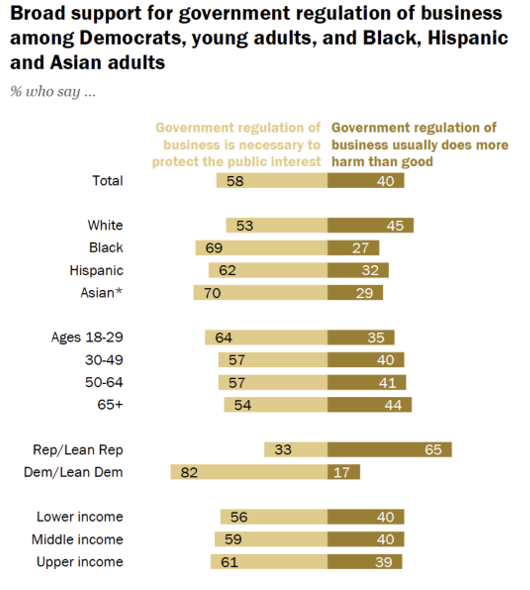
Source: Pew Research
Business leanings also depend on industry, geography, and social policy alignment. Forbes reported 69% of top executives at S&P 1500 firms identify as Republican, a stable trend over 12 years. But Forbes isn’t afraid to incorporate more diverse perspectives. Sean Herman wrote about monopolies and wealth concentration in big tech, saying:
“A more level playing field and decentralization of power won’t guarantee our success, but it will definitely help.”
Other large corporations, especially in tech, media, and finance, are also found to support social and environmental causes. Bryce Erickson covers valuations and economics in the energy space for Forbes magazine. In her article, ‘Change in Republicans’ Thinking Shifts Policy Support in Renewables,’ she highlights areas in which Americans are unified.
“Something both Republicans and Democrats agree on is that phasing out new gasoline cars by 2035 is unpopular… Another is that more nuclear power is a good thing (both parties have majorities in favor of more development in that area).”
Forbes leans liberal in embracing change but values a range of views. It highlights both tradition and innovation. The platform avoids pushing one agenda. Instead, it encourages open dialogue across political and business divides.
Analysis of Bias in Forbes Online Articles
Forbes magazine has found that in-depth coverage of billionaires and prominent politicians is one of the most effective ways to drive subscriptions. Given that much of its readership strives to build individual or company net worth as well, it is essential to ask, is Forbes biased?
To evaluate this, we can analyze select Forbes’ articles through several of Biasly’s bias rating criteria: Tone, Tendency, Author, Diction, and Expediency Bias.
- Tone: The overall attitude conveyed by the article
- Diction: Specific word choices made by the writer
- Author: The background and social presence of the journalist
- Tendency: Patterns of bias in the writer’s broader body of work
- Expediency Bias: Quick visual or textual indicators like headlines and photos that imply bias
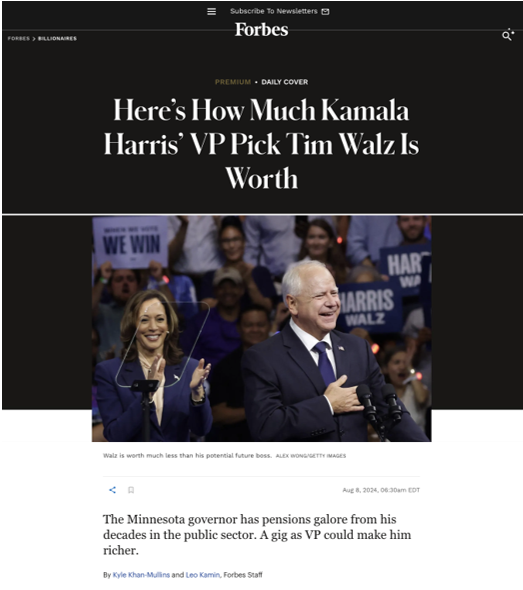
Source: Forbes
One Forbes article is titled “Here’s How Much Kamala Harris’ VP Pick Tim Walz Is Worth.” The reporter, Kyle Khan-Mullins, profiles Minnesota Governor Tim Walz in light of his selection as Kamala Harris’s running mate. The article opens by highlighting Walz’s “working-class background” and extensive public service career. It sets a tone that favors Walz while contrasting him with Donald Trump. He quotes Walz saying of Trump, “He doesn’t know the first thing about service… He’s too busy serving himself.” This frames Trump negatively and appeals to liberal or progressive readers.
Forbes draws positive attention to Walz’s modest net worth of just over $1 million here. It notes this as the closest to the median American’s wealth for someone of Walz’s age. Walz’s wealth composition is primarily “government pensions earned through state, federal, and military careers.” This apparently contrasts with Republican candidates like Trump and JD Vance, who accumulated wealth in the private sector. Khan-Mullins describes Trump’s fortune dismissively as mostly tied to “Truth Social, his Twitter knockoff,” evoking skepticism about its value.
He returns to a neutral tone when describing Kamala Harris’s net worth of $8 million, and then again to positive language for Walz’s background. The article praises his military service, teaching background, and personal hardships. The reporter uses personal details to help create a relatable, working-class image of Walz.
Overall, the article reveals a mild liberal media bias through framing and fact selection. It omits critical perspectives on Walz’s politics. Instead, it highlights Republican wealth to contrast with Democratic modesty and service. The timing, weeks before the 2024 election, suggests an expedient purpose. Forbes’s choice to humanize the Democratic ticket appeals to voters’ economic concerns and shifts attention away from potentially divisive policy discussion.
A second Forbes article, “The Curious Rise of Silicon Valley’s Trump Whisperer,” focuses on tech advisor Jacob Helberg’s growing ties to Trump. The tone is skeptical. Forbes casts doubt on Helberg’s credentials and frames his relationship with Trump as self-serving and strategic. It highlights Helberg’s past as a Biden donor and questions his sudden alignment with conservative causes like deregulating artificial intelligence.
“Helberg’s critics say he’s exaggerating the importance of his tech policy work to boost his political prospects, particularly with GOP donors aligned with Trump.”
The author uses quotes from critics to suggest Helberg is overstating his experience to gain political influence.
Few sources offer strong praise or defense. The article implies Helberg is using political shifts to increase his visibility and power. Continuing, it presents Trump’s support as opportunistic. Therefore, the coverage of this article also leans liberal.
“He’s been a vocal proponent of aggressive U.S. regulation of Chinese technology firms like TikTok and Huawei — views that align with both hawkish Democrats and Republicans.”
It favors Democratic regulation on AI and casts Republican tech allies in a suspicious, even mocking light. While bipartisan in theory, the context and tone of the article show more scrutiny toward the conservative figure. Resources like the politician bias chart can help readers better understand the context surrounding articles like this.
Together, both articles reflect how Forbes blends financial reporting with subtle political framing. Liberal perspectives consistently appear through tone and sourcing choices.
Analysis of Forbes Opinion Articles
To understand media bias, we must distinguish factual reporting from opinion-based content, including advisory and career columns. Traditional opinion pieces clearly express personal views. Advisory articles, however, blend facts with subtle perspective and expert interpretation. These columns guide readers on political, financial, or career choices using trends, data, and industry knowledge. Bias still appears—not through overt arguments, but through topic selection, framing, and which voices are prioritized. This section explores how Forbes’ advisory content reflects discreet forms of opinion and selection bias.
One relevant example is the advisory column “Five Habits of Controlling People.” The title frames the subject as a behavioral flaw, immediately signaling a critical tone. While not overtly political, the article promotes values of autonomy, flexibility, and resistance to social conformity—ideas often associated with progressive or libertarian views. Through personal anecdotes and informal storytelling, the author encourages readers to challenge authority and question rigid norms. Rather than offering balanced perspectives on leadership styles, the piece subtly positions traditional or hierarchical behavior as emotionally unhealthy, favoring self-guided decision-making instead.
One clear example is the Forbes Advisor article ranking ‘The Best Places for Young Professionals to Live in U.S. 2024.’ The tone is factual and data-driven, relying on a comprehensive analysis of 12 metrics across employment, housing, cost of living, and lifestyle. Rather than pushing a particular agenda, the article presents findings in a straightforward, objective manner. It highlights both strengths and challenges in various metro areas without exaggeration or bias. This balanced approach allows readers to make informed decisions based on practical considerations, reflecting a measured and responsible form of advisory content.
Overall, Forbes balances practical information with an underlying optimism about change, which shapes how readers perceive business, culture, and societal issues. Through careful topic selection, Forbes highlights innovation, personal agency, and economic opportunity- values that aren’t associated with any one political party.
In short, Forbes tends to attract readers who are open to progressive ideas about change but grounded in practical business realities, appealing mostly to moderate and business-oriented political perspectives.
Who Owns Forbes?
Forbes began as a family-owned publication, founded in 1917 by Bertie Charles Forbes. In 1990, his son Steve Forbes took over leadership, continuing the company’s legacy in business journalism. It has since grown beyond family ownership and is now co-owned by Integrated Whale Media Investment Inc. and Highlander Management LLC. This shift marked Forbes’ transformation from a U.S.-based magazine into a global media brand with a wide international reach.

Source: Forbes
Today, Forbes employs about 500 people and supports over 2,100 journalists around the world (“Who We Are”). Its magazine publishes eight times a year and reaches 5.33 million readers across 44 editions in 77 countries. As the media landscape has evolved, Forbes has embraced digital tools and diverse platforms to reach a broader, global audience. News is no longer limited to print. Readers now engage through online articles, live-streamed events, podcasts, and multimedia reports.
With faster travel and virtual access, business audiences can attend events or connect with content across states and countries in hours. Forbes reflects this shift by offering flexible, tech-forward content that meets the needs of a mobile, international readership.
How to Evaluate Bias
Although Biasly rates Forbes as Center, it’s important to remember that bias can vary from article to article. Forbes also covers a bipartisan state with objectivity on many issues, from legislation to social developments. This complexity underscores the importance of examining each article individually. So, let’s learn how to evaluate media bias.
Recognizing media bias requires awareness and critical thinking. Often, readers trust news sources that affirm their existing beliefs—a psychological tendency known as confirmation bias. This makes it harder to identify slanted narratives or one-sided reporting.
To combat this, it’s essential to challenge your assumptions by consulting multiple viewpoints and verifying news through third-party analysis. Tools like Biasly’s media bias ratings allow readers to compare the same news story across the political spectrum.
Ultimately, bias isn’t always a matter of what is said—it’s also about what is left out, how topics are framed, and which stories are chosen for coverage. Learning to recognize these patterns can help readers make more informed decisions and develop greater media literacy.
To start comparing news outlets and gain a better understanding of bias, sign up for Biasly’s Media Bias & News Analytics Platform to see how stories vary between sources.
Forbes Reliability Analysis
Forbes magazine, with its focus on business, entrepreneurship, and innovation, caters to this audience of highly educated and accomplished readers. The U.S. bureau of labor statistics shows that in today’s U.S. labour market, 69.9% of financial operations and management occupations require a four-year degree or more. Data USA also shows the highest paying industry, by average wage, to be Securities, commodities, funds, trusts & other financial investments.
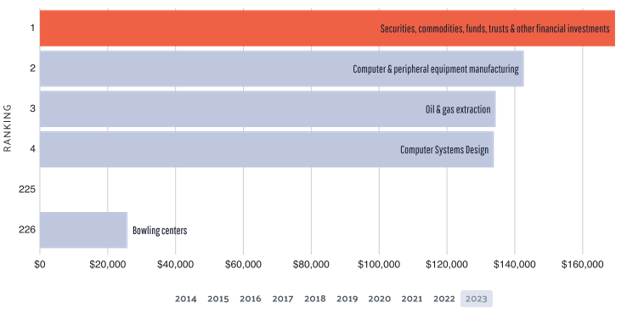
Source: Data USA
Business owners and sales professionals rely on timely, accurate data about demographic shifts and market regulations to succeed. Given its readership’s expertise and demand for reliable information, Forbes must uphold a high standard of accuracy and credibility. Maintaining this reputation has been essential for retaining trust among professionals who depend on the magazine for insights that directly impact their decisions. According to Pew Research, 78% of Americans are familiar with Forbes. This underscores its broad influence and the importance of its role as a dependable news source. Therefore, readers seeking to strengthen media literacy skills can look to Forbes as an example of dependable reporting.
How to Evaluate Reliability?
Reliability refers to how trustworthy or accurate a news source is. If we can’t trust what we read, then continuing to consume content from that outlet serves little purpose. So how do we evaluate a news outlet’s reliability?
There are several potential measures of reliability to look out for when trying to determine whether a media source is reliable or not. Red flags for an unreliable article can include the presence of wild unsubstantiated claims, facts dependent on other unreliable sources, heavy use of opinionated language, and more. In contrast, hallmarks of a reliable source include:
- Absence of subjective language
- Citing credible sources (e.g., .gov, .edu, academic references)
- Verifiable facts and statistics from multiple outlets
- Use of primary sources, like interviews or transcripts
- Consistency with coverage across other platforms
Biasly’s reliability scores incorporate these elements in evaluating media outlets.
So How Does Forbes Fare in Its Reliability?
The political reliability index developed by Biasly assesses both accuracy and trustworthiness. Forbes currently holds Good Reliability Score, which is calculated as a weighted average of:
- Fact Analysis Score – Evaluates the accuracy of claims, facts, and evidence.
- Source Analysis Score – Assesses the number, diversity, and credibility of sources and quotes used.
Forbes Source Analysis Score is rated Good at 85%. This suggests moderate trustworthiness in its sourcing practices. The score is AI-generated and considers quote length, frequency, diversity, and quality.
The Fact Analysis Score is Excellent. This score determines how well Forbes supports its claims, addresses selection and omission bias, and presents verifiable evidence. Until this is available, readers are encouraged to perform their own evaluations using Biasly’s media bias tools.
While Forbes exhibits factual reporting, occasional lapses–such as unbalanced viewpoints and selective data–can effect its reliability rating. These nuances emphasize the importance of analyzing individual articles.
Forbes’ Accuracy and Reliability
According to Biasly’s analysis, Forbes maintains Good Reliability Score, but individual articles may vary significantly. Let’s dive into the details.
Political orientation plays a crucial role in how audiences perceive reliability. Forbes has been accused of favoring a liberal narrative, but also occasional conservative highlights. To validate such claims, it’s essential to analyze whether the publication backs any of its assertions with sufficient evidence and diverse viewpoints.
Two common types of bias that affect factuality include:
- Selection Bias – Highlighting or omitting stories to fit a particular narrative.
- Omission Bias – Leaving out differing perspectives or relevant details to skew perception.
Biasly’s accuracy ratings use a scale from 1% (least accurate) to 100% (most accurate). Factors include the presence of supporting evidence, internal and external reliable sources, and balanced viewpoints.
The Wall Street Journal is a good example of a contrasting outlet with a Somewhat Conservative bias and a Good Reliability score. As presidential decisions dictate the economy, WSJ published an article titled Tech, Media, and Telecom Roundup: Market Talk. The story earned a center rating, as well as a center position for policy leanings. The most negative sentiment expressed concerned government spending, but was grounded in factual updates. However, WSJ focuses more heavily on political controversies, as its target audience reaches a broader range than the business sector. Collin Eaton represents conservative preferences in Exxon says Trump Should Keep U.S. in Paris Climate Pact. He noted the uncertainty the failure to support Trump would cause in efforts to stop climate change, contributing to the Somewhat Right leaning given to the article. However, this creates a fascinating juxtaposition as liberal interests in climate change collide with conservative support for the Republican President.
Although WSJ is found on the opposite side of the spectrum, its articles address a similar concept as many Forbes articles. Despite having to navigate intense partisan divides, citizens both owning and supporting businesses have the common desire to achieve stability and success.
We will take a look at more examples by Forbes to provide further investigation into its accuracy and reliability. This will include the quality of its sources and the facts it uses, as well as the intent behind them.
Analysis of Reliability in Forbes’ Online News Articles
One of Forbes’ articles is titled ‘Federal Policies Set a New Tone for Business.’ Forbes’ newsletter covers Trump’s first week back in office, detailing major executive orders on DEI, remote work, and AI. One order ended all federal DEI programs, calling them “immense public waste and shameful discrimination.” The article reports this language directly, avoiding editorial tone. It then contrasts Target’s decision to scale back diversity goals with JPMorgan CEO Jamie Dimon’s response: “Bring them on.” By including both, the article shows political division in business reactions without pushing a clear stance.
The piece highlights potential ripple effects but keeps the focus on how policies may affect business operations. It explains that Trump’s return-to-office mandate could pressure private companies to do the same. At the same time, it quotes critics who call the move damaging to workplace culture. These varied voices—from CEOs to policy analysts—help readers see different sides. The author gives no personal opinion and uses quotes and facts to build context, making the reporting appear neutral and fact-based.
Quality of Sources and Facts Used
Forbes uses credible sources almost exclusively. However, noticing variation in their political leanings sometimes requires looking at more than one article. Individual articles can skew how comprehensively the topic is being covered and limit opposing viewpoints.
In 10 Reasons Its Time To Kill GE’s Unneeded Fighter Engine Loren Thompson presents a detailed case against funding General Electric’s alternate F-35 engine. The reporter openly favors upgrades to the current Pratt & Whitney F135 engine. The piece is clearly structured, laying out ten concise reasons focused on cost-efficiency, logistics, technical feasibility, and joint interoperability. Thompson uses specific comparisons as support, such as cost estimates and weight differences between engines. Historical examples of past upgrade practices also strengthen his evidence.
Towards the end, however, he discloses his financial connection to Raytheon Technologies (Pratt & Whitney’s parent company). While ensuring transparency, this reveals that the reporter wrote the article with an objective in mind.
More direct quotes or perspectives from GE, Pentagon officials, or independent defense analysts could have balanced Thompson’s own views. The only direct quote is a short reference to Air Force Secretary Frank Kendall’s mixed signals. GE’s perspective, while mentioned, is not directly included.
The article still contributes to the conversation by breaking down defense issues in accessible terms. Despite supporting a specific view, the author avoids partisan framing. Sticking closely to defense logistics and budget concerns rather than political rhetoric produces strong evidence. This causes Thompson’s tone to remain professional throughout.
Another Forbes article is titled ‘Here’s How Much Trump is Worth.’ This article displays more objective reporting and primarily lists Forbes’ financial estimates with short descriptions. Rather than multiple sourced quotes from experts or stakeholders, the information is presented as quantitative data. This creates a positive focus on objective information but reduces the diversity of perspectives presented through firsthand voices.
The most notable quote is from Donald Trump himself, taken from The Art of the Deal: “Money was never a big motivation for me, except as a way to keep score.” Dan Alexander uses this medium-length quote to reference Trump’s attitude toward money.
Regarding sources, the article leans heavily on Forbes’ internal financial analysis, public property records, and filings related to Trump’s businesses. It also references a real estate analyst, Kevin Brown. True to its values, the article does not include any political figures or explicitly partisan sources. The absence of politicians or party-affiliated voices helps maintain a business-focused and relatively neutral source base. The article’s reliance on verifiable, nonpartisan financial data rather than ideological commentary contributes to an impression of impartiality.
Here are 7 of the most noteworthy sources:
- Forbes’ internal financial estimates and analysis
- Public property and tax records for Trump’s real estate holdings
- Stock market data related to Trump Media and Technology Group
- Real estate analyst Kevin Brown’s commentary on Trump’s brand damage
- Legal filings and court case information on Trump’s liabilities
- Sales and debt information from Trump’s golf clubs and resorts
- Quotes from Donald Trump’s book The Art of the Deal
Even with reliable sources, however, selection and omission of information subtly shape Alexander’s article. The piece highlights critical points to evoke skepticism in its readers. Trump allegedly overstates property sizes and the “absurd” state of his social media business. Such criticism is not necessarily synonymous with bias, as the focus is on misinformation.
Yet, Alexander omits any responses or defenses from Trump or his representatives. This leaves readers without a counterbalance to the reporter’s critiques. Additionally, the article excludes broader market comparisons that could contextualize Trump’s financial situation. These omissions steer readers towards questions about Trump’s business claims, which reduces overall objectivity.
The article is consistent with other Forbes content published by the same reporter. Alexander mentions his book ‘How Donald Trump Turned The Presidency Into A Business’ in his Twitter bio. While he rarely strays from reposting political articles, he occasionally shares personal commentary on Trump’s presidency.
“This is one of those moments where Trump does something out in the open that would be a major scandal if he did it in private,” he says in response to the President’s Twitter post about Harvard.
This is one of those moments where Trump does something out in the open that would be a major scandal if he did it in private.
Because it’s out in the open, people will probably assume it’s no big deal, giving him license to push the envelope even further.
— Dan Alexander (@DanAlexander21) April 24, 2025
Selection and Omission Bias
Forbes provides extensive coverage of prominent companies in the US, and politics are one component in their decision-making processes. However, bias may still emerge in their stories depending on how information is presented.
One of their articles is titled IBM Reportedly Walks Back Diversity Policies, Citing ‘Inherent Tensions:’ Here Are All The Companies Rolling Back DEI Policies. The author, Conor Murray, uses short, concise language and sticks to logistical changes in the companies. He uses limited commentary following a timeline, in which his tone towards Trump is measured. While there is a lack of quotations, dialogue over Diversity, Equity, and Inclusion policies tend to be emotionally charged and biased.
“Trump also signed an executive order eliminating DEI offices and policies within the military, Department of Defense and Department of Homeland Security, which he considered to be “race-based and sex-based discrimination,” and in a separate executive order, effectively reinstated his 2017 ban on transgender troops, banning “identification-based pronoun usage” and prohibiting troops assigned male at birth from using women’s bathing or sleeping facilities.”
Excerpts like this, where what some might consider official terminology is in quotation marks, acknowledge that not everyone shares the same views. Phrasing can convey underlying prejudice. Rather than describing events himself, Murray incorporates a balance of statements from various parties to provide full coverage of the story.
Another article, however, uses a more descriptive style where Forbes’ political leanings are more transparent. 10 Journalism Brands Where You Find Real Facts Rather Than Alternative Facts is particularly respectful of progressive media. The title alone suggests a right and a wrong classification of media, assuming Forbes’ alignment with ‘real facts’ to solidify credibility on the matter.
Paul Glader, the reporter, praises progressive outlets, even while noting their bias. Words like “treasure” and “influential” show strong approval. Conservative sources are mentioned, but with less detail and enthusiasm. This omission of sources and references causes one-sided coverage. Readers can therefore hold these recommendations in high esteem, but must supplement them with voices that have differing views.
So, Is Forbes Reliable?
Overall, Forbes can be considered a very reliable news outlet. It demonstrates a consistent goal of journalistic integrity and typically supports claims with sources and quotes. Occasional omissions and framing bias do appear, particularly on culturally sensitive or partisan issues.
That said, no single outlet can give the full picture—especially on issues where politics and business intersect. Forbes tends to present information through a market-oriented lens, often emphasizing corporate strategy and leadership decisions over social or ideological debate. While this can help avoid overt partisanship, it may also limit the diversity of viewpoints or omit deeper cultural context. Readers benefit most when they treat Forbes as one piece of a broader media diet: its reporting is often fact-based and pragmatic, but pairing it with outlets that prioritize social impact, investigative depth, or alternative political perspectives offers a fuller understanding of today’s complex issues.
Additional Insights
News Source Comparison
Comparing news sources like Forbes with others across the media landscape highlights how political perspectives and audience priorities influence reporting styles and perceived reliability. For example, The Wall Street Journal leans more conservative and often emphasizes political controversies, while Forbes tends to blend business insights with subtle liberal framing. Some outlets focus heavily on culture or social issues, whereas others prioritize economic analysis or policy debates. These differences shape tone, topic choice, and framing, reflecting distinct editorial goals. Recognizing such contrasts helps readers navigate diverse viewpoints, identify biases, and develop a well-rounded understanding of complex issues in today’s fast-changing media environment.
Notable Contributors and Authors
Forbes maintains a diverse and dynamic contributor network, with over 2,800 editors, journalists, and contributors globally.
Some of the prominent figures include Randall Lane, Forbes’ Chief Content Officer and Editor-in-Chief, who leads the editorial direction and created the influential “30 Under 30” list. Moira Forbes, Executive Vice President of Forbes Media and President/Publisher of ForbesWoman, champions women’s leadership and entrepreneurship. Dr. Robert Pearl, a healthcare leader and former CEO of The Permanente Medical Group, contributes insights on healthcare leadership and policy. Rachel Wells, a freelance writer, covers topics related to remote work, freelancing, and AI. Samantha Walravens leads the “Geek Girl Rising” series, highlighting women in tech.
Related Tools and Resource Pages
To better understand how Forbes fits into the broader media landscape, we recommend exploring these helpful resources:
- Media Bias Chart: See where Forbes ranks among hundreds of media outlets across the political spectrum.
- Political Bias Chart: Visualize political slants of news sources across various policy areas.
- Journalist Bias Analytics Platform: Explore how individual journalists contribute to bias within their publications.
- Politician Bias Analytics Platform: Compare how politicians are framed differently by Forbes and other outlets.
- Media Literacy Education Platform: Learn how to critically assess media sources, bias techniques, and news reliability.
Frequently Asked Questions
Forbes is rated as Center, based on Biasly’s media bias algorithm, which assesses sentiment, article framing, and policy favorability
No, Forbes has not been formally accused of publishing fake news or misinformation. Forbes maintains a reputation for delivering timely and relevant business news.
Biasly uses a combination of AI sentiment analysis and human analyst review to assess tone, fact accuracy, source quality, and media bias indicators. Learn more on our Bias Meter page.
Forbes is consistently reliable for fact-based reporting, especially in business and economic coverage. Its articles often include supporting evidence and cite credible sources, which helps maintain accuracy. However, individual pieces can vary in quality due to the wide range of contributors. Overall, Forbes largely upholds journalistic standards, making it a trustworthy source for readers seeking practical business insights.
Ratings are based on recent news using data science and A.I. technology.
Military Spending
| Date | Sentiment | Associated Article | Snippet |
|---|---|---|---|
| 08/25/2019 | 75% For | Trump Family Detentions Flores Agreement (link) | So, of course, the Trump administration is doing the opposite in a baldfaced |























